Although born in the Hampshire village of Steventon, the author of novels such as Pride and Prejudice and Sense and Sensibility had many reasons to visit London during her life. In fact, many of the sites Jane Austen visited served as direct inspiration for descriptions of fashionable neighbourhoods where characters such as Mrs Jennings from Sense and Sensibility live. The capital’s social events, attractions and theatres enjoyed by the affluent classes, so vividly described in Austen’s novels, were part of her own experiences. Get a glimpse into the life of one of England’s most acclaimed authors, as we visit ten sites connected with this most sharp-eyed genteel woman. Let me, a Blue Badge Tourist Guide, show you Jane Austen’s London.
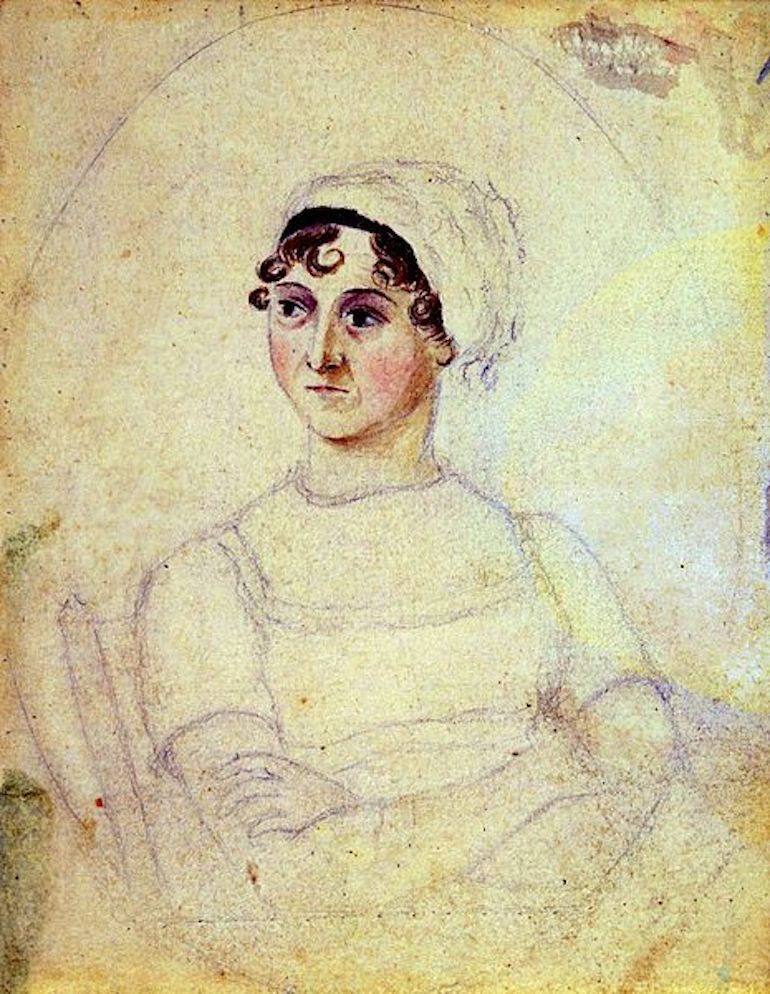 Portrait of Jane Austen by her sister Cassandra, in watercolour and pencil. Photo Credit: © Ingrid M Wallenborg.
Portrait of Jane Austen by her sister Cassandra, in watercolour and pencil. Photo Credit: © Ingrid M Wallenborg.
The Wealthy Brother
One of Jane Austen’s six brothers, Henry, lived at 64 Sloane Street with his wife, Eliza, Jane’s cousin and a dear friend. Henry was Jane’s favourite brother and most like her in temperament. He and two associates had founded a bank – Austen, Maunde and Tilson – and he lived the life of a London businessman in this still quite rural part of the capital until 1815. He was also instrumental in helping Jane publish her work. Jane stayed at Henry’s home during her trips to London, visits which gave her an insight into society life. Henry happily entertained his sister with parties and trips to the theatre. Today, the building houses an investment bank, and its façade was refaced in 1897. However, the original house inside dates to sometime after 1780.
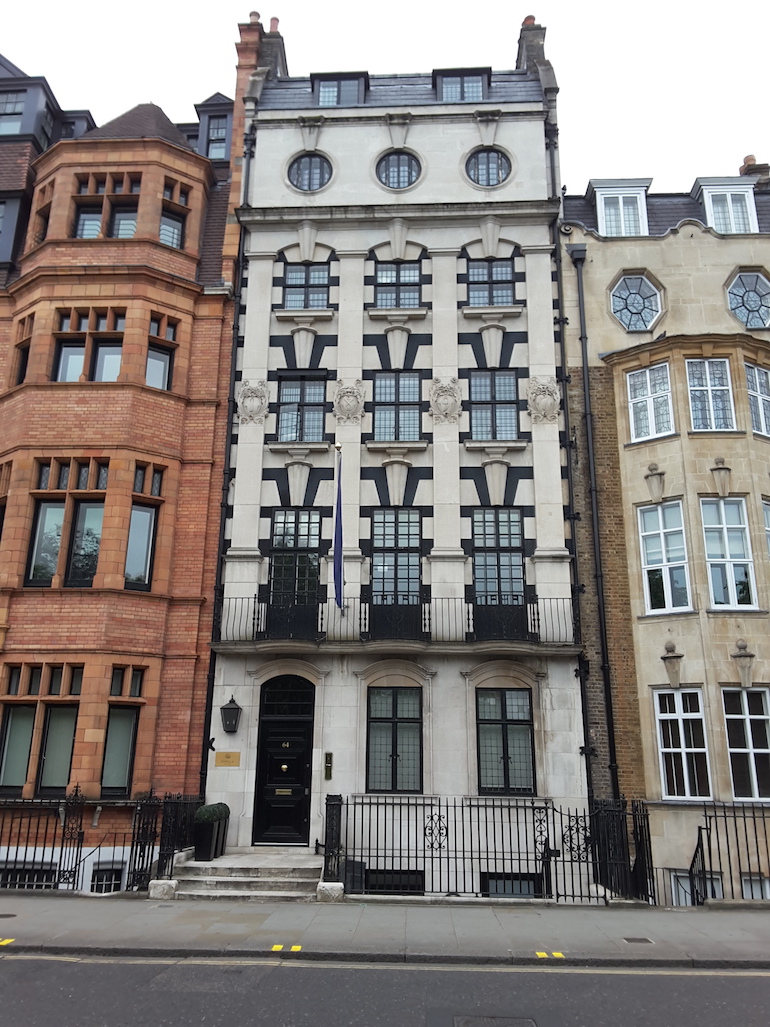 64 Sloane Street in London. Photo Credit: © Ingrid M Wallenborg.
64 Sloane Street in London. Photo Credit: © Ingrid M Wallenborg.
The Blond Handsome Irishman
Austen, who never married, was 20 when she flirted briefly with Tom Lefroy, a blond, handsome Irishman who was the nephew of her neighbour in Steventon, Madam Lefroy. Jane’s version of the “affair” is recorded in her letters to her sister, Cassandra. In them, she reassures her sister that there was nothing serious going on, but that she enjoyed his attention. After spending time with Jane and his relatives, Tom Lefroy returned to his legal studies at Lincoln’s Inn – one of London’s four Inns of Court – and went on to become Chief Justice of Ireland. He later admitted that he had indeed been in love with Jane, but was not in a financial position at the time to offer marriage. Perhaps just as well.
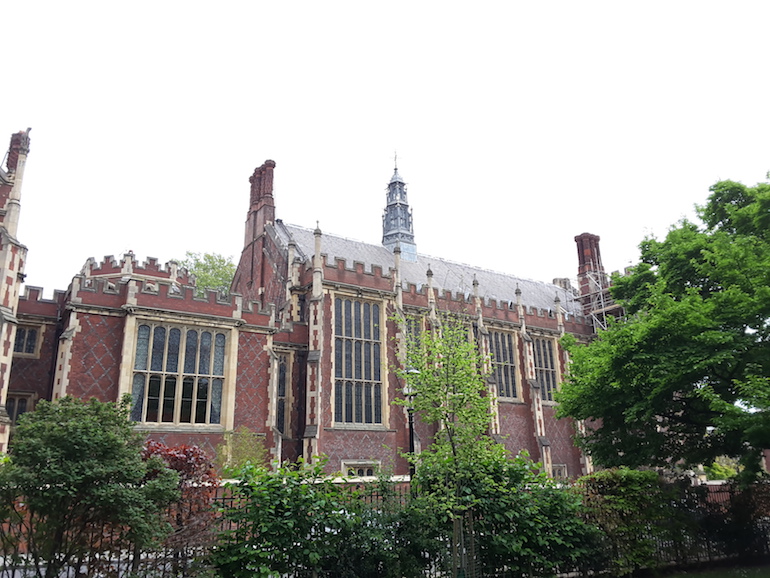 The Honourable Society of Lincoln’s Inn. Photo Credit: © Ingrid M Wallenborg.
The Honourable Society of Lincoln’s Inn. Photo Credit: © Ingrid M Wallenborg.
Sudden Death
Jane stayed with her brother Henry at 10 Henrietta Street during the summer of 1813 and in March 1814. Henry, a clever, confident and naturally optimistic individual, was devastated in 1813 by the death of his beloved wife, Eliza. She had married Henry after her first husband, a French army captain, was guillotined in 1794 during the French Revolution. Eliza and Jane had corresponded through letters, and both shared a love of the theatre. Henrietta Street would have been a very short walk from both the Covent Garden and Drury Lane theatres. The witty Eliza may in fact have influenced Jane’s depiction of sparkling women, e.g. Elizabeth Bennet in Pride and Prejudice. Soon after his wife’s death, Henry moved to rooms here at number 10, above his own bank, where Jane and one of her favourite nieces, Fanny Knight, visited him in 1814.
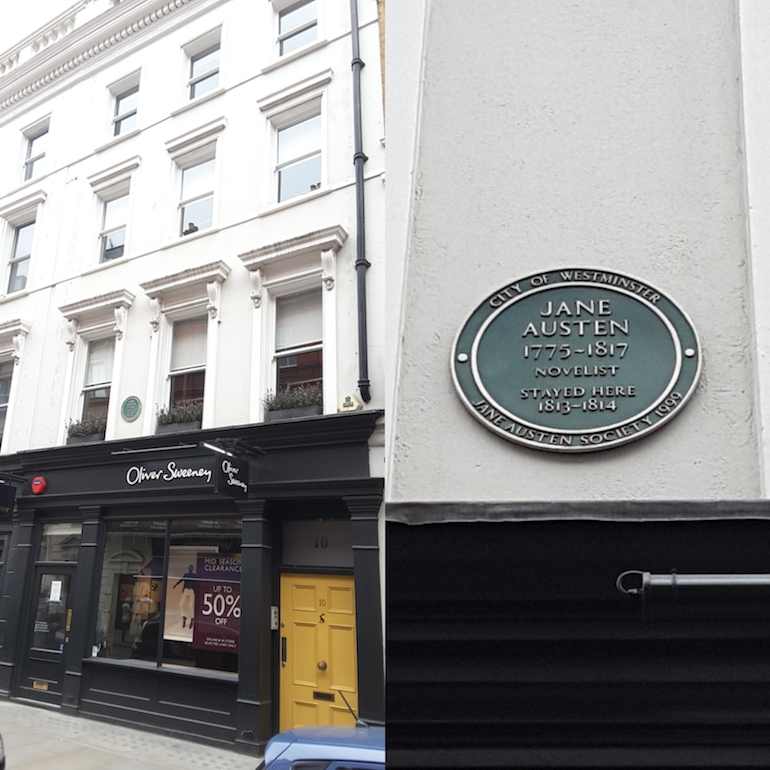 10 Henrietta Street in London. Photo Credit: © Ingrid M Wallenborg.
10 Henrietta Street in London. Photo Credit: © Ingrid M Wallenborg.
A Love Of Great Drama
Jane loved Shakespeare and going to the theatre. During her childhood, her family organised amateur theatricals, choosing plays typical of late 18th-century comic theatre, e.g. The Rivals by Sheridan. In the 18th century, theatre became a highly fashionable way to spend the evening. When visiting Henry, Jane seems to have gone to the theatre as often as possible, seeing some of the greatest actors of her time, including Mrs. Siddons (the Queen of Tragedy) and Mrs Jordan. In 1814, a new star of tragedy burst onto the London stage, Edmund Kean, who excelled as Richard III and Shylock. While in London negotiating publication of Mansfield Park, Jane saw him perform at Drury Lane. She wrote afterwards: “We were quite satisfied w Kean. I cannot imagine better acting, but the part was too short”.
As a result of protective royal patents, London only had two theatres at the time: Covent Garden (on the site of today’s Royal Opera House) and the Theatre Royal, Drury Lane. In Sense and Sensibility, Willoughby hears about Marianne Dashwood’s illness from Sir John Middleton after they meet unexpectedly in the lobby of the Theatre Royal, Drury Lane.
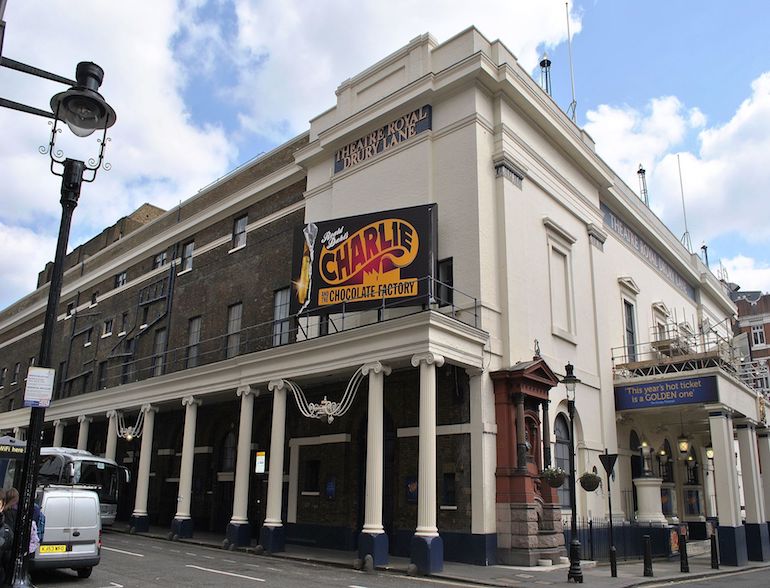 Theatre Royal, Drury Lane in London. Photo Credit: © Elisa Rolle via Wikimedia Commons.
Theatre Royal, Drury Lane in London. Photo Credit: © Elisa Rolle via Wikimedia Commons.
Solitary Coolness
Henry moved to 23 Hans Place in 1814, a year after Eliza died. Jane stayed at this house in 1814 and 1815. She was fond of the building and especially the square’s garden. Her visit in 1815 coincided with her preparing Emma for publication. Her brother became seriously ill, so Jane stayed to nurse him back to health. She had a room downstairs that overlooked the garden, and she describes her routine of working indoors, then having a break outside: “I go & refresh myself every now & then, and then come back to Solitary Coolness.”
Not long after he’d recovered from his illness, Henry’s bank crashed, bankrupting him and causing family members, including Jane, to lose money. This was probably her last visit to “town’, as she died 19 months later. Today, some houses from the period survive, but No. 23 has been redeveloped. A blue plaque commemorates Jane’s time at this residence.
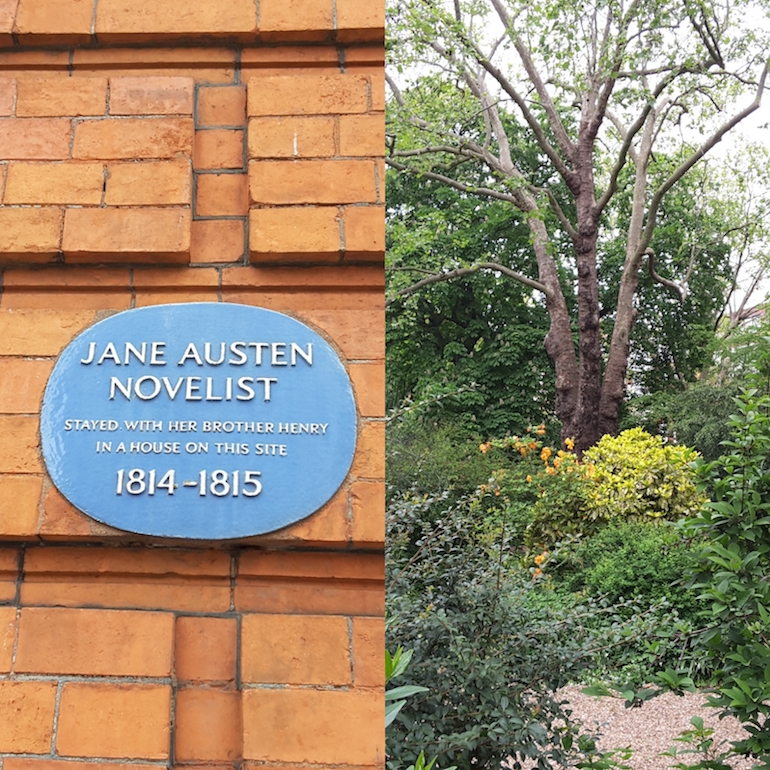 The garden square at 23 Hans Place where Jane Austen refreshed herself. Photo Credit: © Ingrid M Wallenborg.
The garden square at 23 Hans Place where Jane Austen refreshed herself. Photo Credit: © Ingrid M Wallenborg.
A Royal Admirer
Carlton House was the London townhouse of the Prince Regent (the future King George IV) from 1783 until it was demolished in 1823. It has since been replaced by Carlton House Terrace, overlooking St. James’s Park. Apparently, the Prince Regent was a great admirer of Jane Austen’s novels and had “often read them”. Once aware that Jane was in London, he asked his librarian “to wait upon her”. So the Reverend James Stanier Clarke called on her at 23 Hans Place, inviting Austen to visit Carlton House. She was given a guided tour by the librarian himself, which included a view of the Prince’s opulent library. It was during this visit that he “invited” her to dedicate her latest novel, Emma, to the Prince. This she did reluctantly, for she was no great admirer of his. She had, in fact, written about the Prince’s long-suffering wife, Princess Caroline, in one of her letters: “Poor woman, I shall support her as long as I can, because she is a Woman and because I hate her Husband.”
The rather pompous reverend was so struck by Jane that he painted her watercolour image and kept up a correspondence with her afterwards, including advising her to write a novel about an English clergyman.
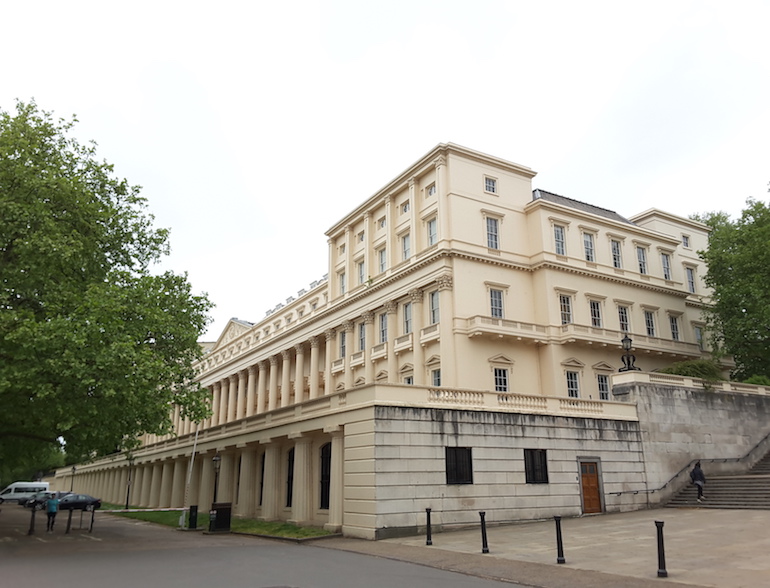 Carlton House Terrace, on the site of the former Carlton House. Photo Credit: © Ingrid M Wallenborg.
Carlton House Terrace, on the site of the former Carlton House. Photo Credit: © Ingrid M Wallenborg.
‘Never Take Coffee’
The oldest tea shop in London, at 216 the Strand, has been in business for over 300 years. Developed by Thomas Twining, this was probably the world’s first dry tea and coffee shop. We know the Austen family, including Jane, visited the shop. Jane wrote in her diary that her mother had asked her to pick up some tea at Twinings to bring back home. She also referred to the price of tea going up in a letter to Cassandra. Apart from Jane Austen, other famous visitors to Twinings included the artist Hogarth, whose bill was so huge that he painted a portrait of Richard Twining in lieu of payment. A copy is displayed in the shop. Another regular was Earl Grey, British prime minister in the 1830s, whom the tea was named after. In Jane Austen’s day, drinking tea was the preferred activity for women, though coffee certainly features in her novels. Miss Bates in Emma was in no doubt as to her preference:
“No coffee, I thank you, for me — never take coffee. A little tea if you please, sir,….!
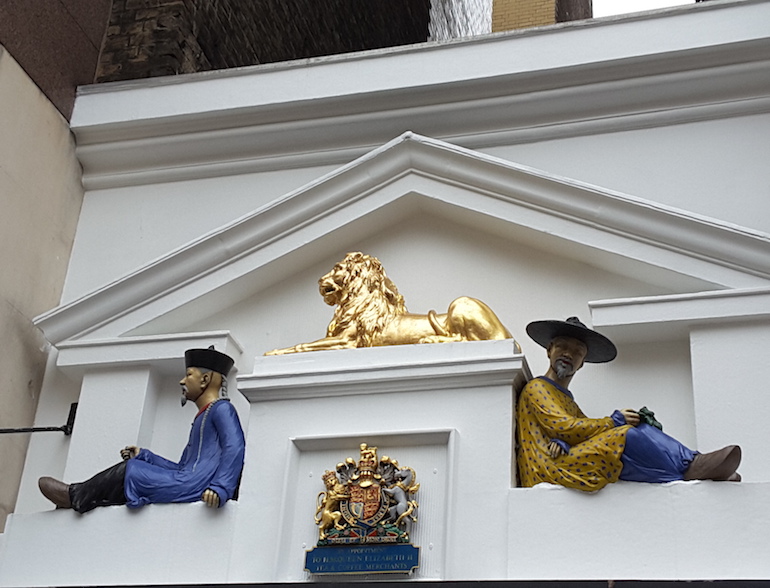 Twinings Tea Shop, 216 Strand, Temple, London. Photo Credit: © Ingrid M Wallenborg.
Twinings Tea Shop, 216 Strand, Temple, London. Photo Credit: © Ingrid M Wallenborg.
The Same As Lord Byron
Austen changed publishers in her later years. She let the successful John Murray at 50 Albemarle Street publish Emma in December 1815 and a second edition of Mansfield Park soon after. These were the last of Jane’s novels published during her lifetime. She would certainly have visited John Murray’s office in 1815. It was the centre of a literary circle, the so-called Four o’clock friends, who were writers who came in for afternoon tea! Murray was mainly a publisher of modern poetry, travel books and history rather than novels. However, he might have been persuaded to take a chance with Austen’s work. He offered just under £450 for the copyright of Sense and Sensibility, Mansfield Park and Emma, not the greatest of deals from Austen’s point of view. However, it meant she could say that she was the first female novelist published by the same house as Lord Byron, the most famous living poet! In 1859, John Murray would go on to publish Charles Darwin’s On the Origin of Species. No. 50 Albemarle Street has remained the home of the publisher, which was sold in 2002, for more than 200 hundred years.
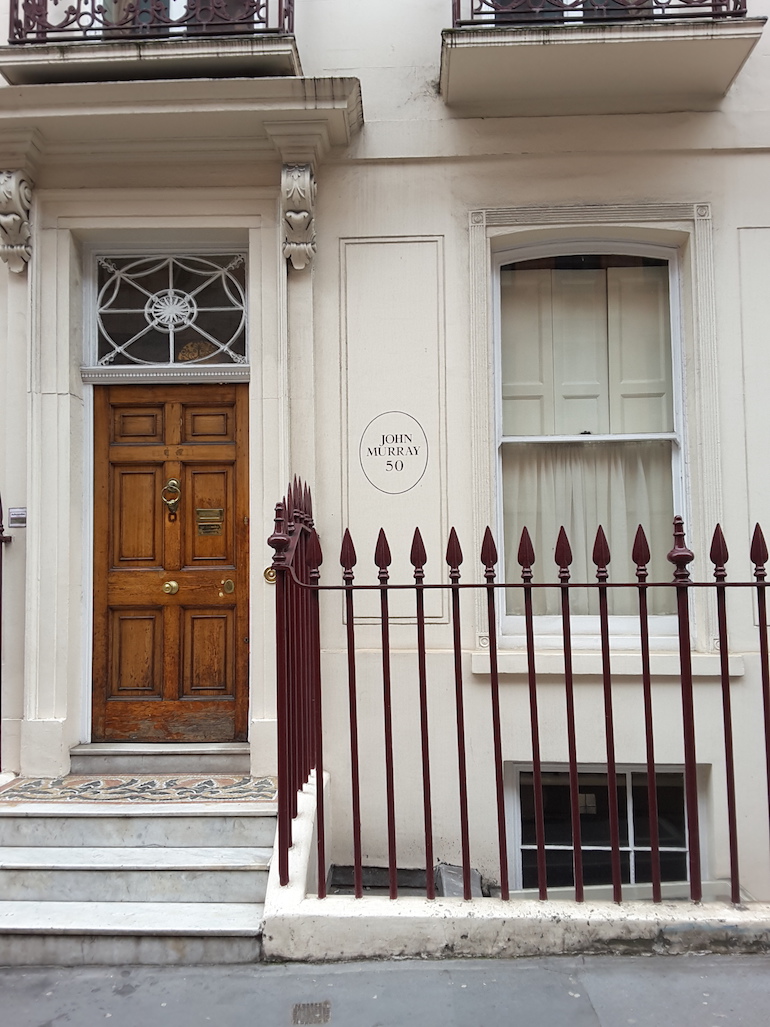 50 Albemarle Street in London. Photo Credit: © Ingrid M Wallenborg.
50 Albemarle Street in London. Photo Credit: © Ingrid M Wallenborg.
Jane’s Laptop
In 1794, Austen’s father gave her a portable “writing-box” which is kept at the British Library. When opened, it provides a sloping surface for writing, and it has space for an inkpot and a drawer for valuables. She may have used this very desk when producing first drafts of what would become Sense and Sensibility and Pride and Prejudice. The desk was inherited by Cassandra and later by their eldest brother’s family. In 1999, Jane’s great-great-great-niece, Joan Austen-Leigh, gave it to the British Library. Inside were three pairs of spectacles that belonged to Jane, according to family tradition. The British Library also holds a letter Austen wrote in April 1816 to James Stanier Clarke, the Prince Regent’s Carlton House librarian. He had suggested in previous correspondence that she write a historical romance. Austen tactfully declined, and in her letter explained that she “could not sit seriously down to write a serious Romance under any other motive than to save my Life”. James Stanier Clarke is not unlike the cringe-worthy character Mr Collins in Pride and Prejudice, although he had already been created by the time Austen met him. Note that the items related to Austen are not always on public display, but can always be accessed online.
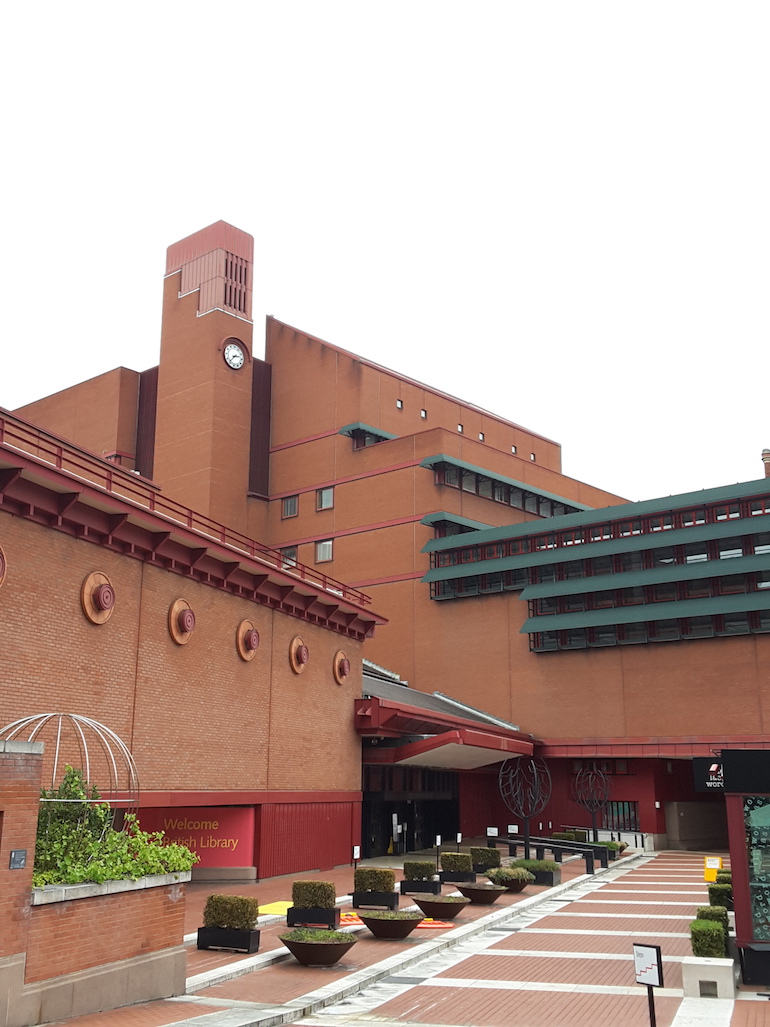 The British Library, Euston Road, London. Photo Credit: © Ingrid M Wallenborg.
The British Library, Euston Road, London. Photo Credit: © Ingrid M Wallenborg.
An Untimely Death
Austen is buried in Winchester Cathedral, but there is a small wall tablet to her memory in Poets’ Corner in Westminster Abbey. It is close to Shakespeare’s memorial, something which would have thrilled Austen. Let a Blue Badge Tourist Guide show you this – and the memorial to Lord Byron – on a Westminster Abbey Tour.
Austen travelled to Winchester to seek medical help after becoming seriously ill, but she died, aged just 41, in her sister’s arms. Her death has been attributed to many things including cancer, Addison’s disease and even arsenic poisoning. Her modest funeral was attended by just four people and her original memorial stone in Winchester Cathedral made no mention of her books. Now, two centuries later, Austen is celebrated as one of England’s greatest novelists and thanks to the successful film adaptations, the proud Mr Darcy will never be forgotten!
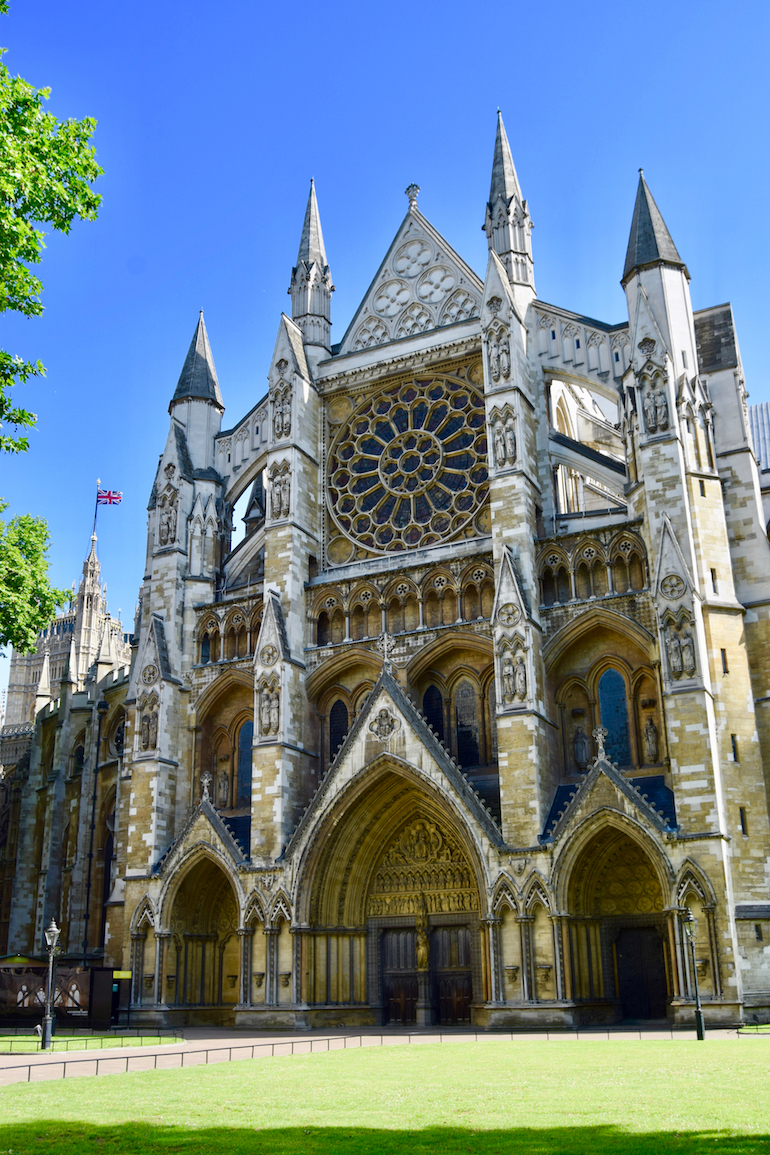 North facade of Westminster Abbey in London. Photo Credit: © David Streets.
North facade of Westminster Abbey in London. Photo Credit: © David Streets.



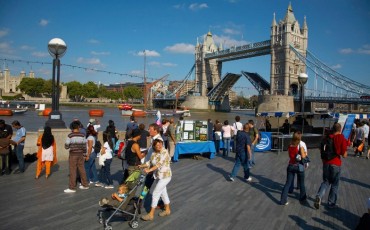
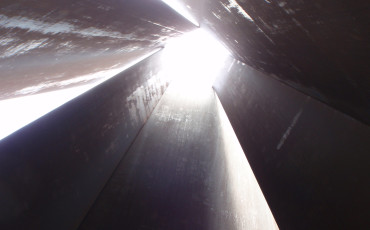


Leave a Reply